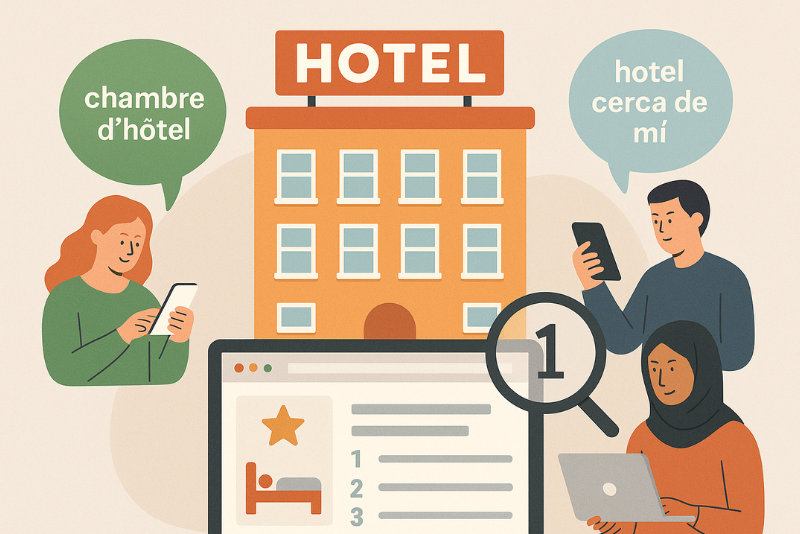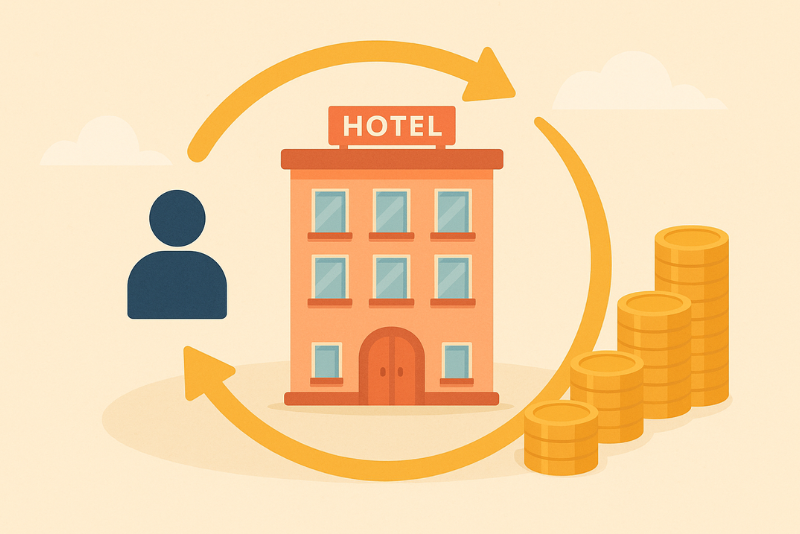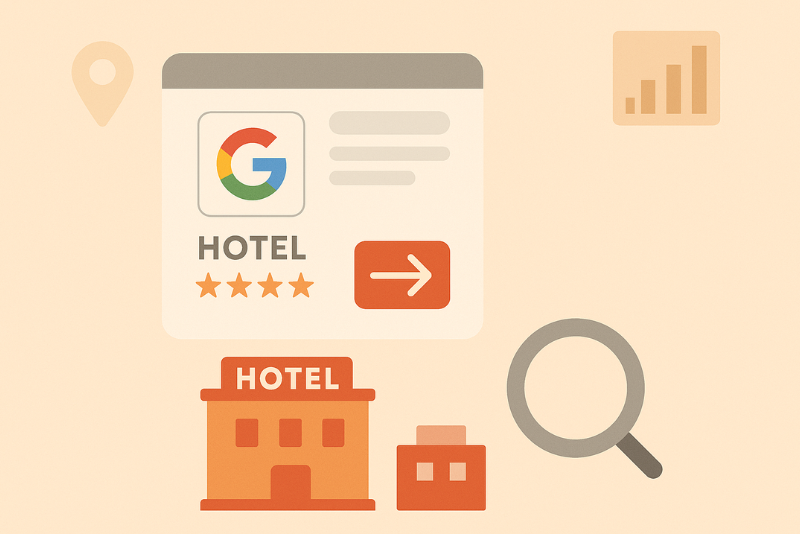Multilingual SEO for Hotels to Attract International Guests: Step-by-Step Guide
Multilingual SEO is essential for hotels that target international guests.
A global survey of online consumers found that 76% prefer to buy in their native language, and 40% never purchase from sites in other languages.
Multilingual SEO for hotels helps to achieve global visibility by reaching international audiences and opening new markets.
Multilingual SEO is the process of making your website findable and appealing to guests in their language. The result?
More trust, longer site visits, and more direct bookings. Having a multilingual website not only attracts international guests but also improves your chances of being discovered by travelers from around the world.
But simply translating your site isn’t enough. Guests expect natural, culturally adapted content that feels like it was written just for them. Cultural relevance in translation and branding is crucial to connect with a global audience and avoid missteps.
This guide walks you through the exact steps to make that happen, helping hotels connect with a global audience and build trust with international guests.
Step 1 – Identify Target Languages for Multilingual SEO Success

Why this matters
Choosing languages based on assumptions wastes resources. By segmenting your target audience and language groups, you can maximize the impact of your multilingual SEO efforts. Data ensures you focus on markets that actually drive bookings.
How to do it
- Analyze booking data – Export reports from your PMS or booking engine to see where your guests come from, focusing on both volume and revenue.
- Check Google Analytics – Go to Audience → Geo → Language & Location to see which languages are already visiting your site. Identify the most preferred language of your website visitors, and tailor your content accordingly.
- Review tourism board data – National and regional tourism boards often publish reports highlighting inbound visitor trends.
- Validate with keyword research – Use tools like Google Keyword Planner, Ahrefs, or SEMrush to check search volume in each language. Analyze relevant terms and incorporate local keywords for each language to improve your visibility in local search results.
Pro tip: Start with your top 2–3 target languages for maximum impact.
Step 2 – Create Localized Hotel Content with Native-Speaking Writers

Why this matters
Guests notice the difference between machine translation and content written by native speakers. Using appropriate language builds trust and engagement with international guests, while poor translations can undermine confidence and lose you customers.
Hiring native-speaking writers with hospitality experience costs more — but it delivers emotionally persuasive copy that makes guests want to book.
How to do it
1. Hire the right talent
- Seek writers who understand both language and local culture. For complex or critical content, consider using professional writers to ensure accuracy and cultural relevance.
- Provide a clear brief covering tone, must-have details, and brand guidelines.
2. Answer common traveler questions in each language
Include multilingual content that addresses common traveler questions in each language, such as:
- Airport transfers and local transport.
- Accepted payment methods and currencies.
- Amenities (Wi-Fi, breakfast, pool, gym).
- Policies (check-in/out times, cancellation rules).
- Recommendations for dining, attractions, and events.
3. Adapt for cultural expectations
Guests from different parts of the world will have different concerns and needs. They will have various pain points, and you must write content that meets their specific needs.
4. Use real traveler language
- Identify question-based search queries in each language, and use appropriate language for each target audience to ensure authenticity.
- Integrate them naturally so the text feels like a conversation, not a keyword dump.
Step 3 – Structure Hotel Web Pages to Keep Guests Engaged
Why this matters
A multilingual website with a strong focus on user experience can significantly increase engagement and bookings. Time on page and multiple page views signal to search engines that your content is relevant and high-quality — and they make guests more likely to book.
How to do it
- Break up text – Use short paragraphs, headings, and bullet points.
- Create logical paths – Link “Rooms” → “Dining” → “Local Experiences” → “Special Offers.”
- Use localized visuals – Photos with translated captions, videos with subtitles, and interactive maps in the target language.
- Implement language switching features – Add a visible language selector, such as a dropdown menu or flags in the website header or top navigation, to allow users to switch between languages and improve navigation easily.
- Offer extras – Seasonal guides, event-specific landing pages, downloadable itineraries.
Pro tip: Well-linked multilingual pages encourage guests to explore more of your site, boosting both SEO and booking likelihood.
Step 4 – On-Page SEO for Multilingual Hotel Websites (Including AI Optimization)

Why this matters
On-page SEO, or search engine optimization, makes it easier for both guests and search engines to understand and find your content. With AI-driven search tools like Google’s SGE and ChatGPT shaping how travelers plan trips, you need content that’s keyword-optimized and AI-friendly.
How to do it
1. Optimize every page element in the target language
- Meta titles & descriptions – Include researched keywords naturally, while making them enticing to click.
- Headings (H1, H2, H3) – Structure them logically with relevant terms.
- Image alt text – Describe visuals accurately in the correct language.
- Internal link text – Translate links; avoid mismatched languages.
2. Structure content for clarity and depth
- Use a clear heading hierarchy so search engines and AI tools can understand it; a well-structured hierarchy helps search engines understand your content and its relevance.
- Include detailed, engaging descriptions of rooms, amenities, and local attractions.
- Use lists, bullet points, and tables for scannable, AI-friendly formatting.
3. Optimize for AI-driven search
- Write in natural, conversational language so AI assistants can present your content as answers.
- Include specific, factual details (distances, facilities, transport info).
- Add question-based headings to target People Also Ask, featured snippets, and AI-generated search results. This helps your content appear more prominently in search results.
4. Maintain technical SEO for multilingual targeting
- Use hreflang tags for correct language targeting.
- Use reciprocal links between language versions and hreflang tags to avoid duplicate content across different languages and language variants.
- Have unique URLs for each language. Choose the proper URL structure (such as subdirectories or subdomains) for your multilingual site or hotel site to improve SEO and user experience.
- Implement schema markup, such as Hotel schema, on multilingual websites and hotel sites to enhance search results with rich snippets.
- Optimize for screen readers and accessibility in multiple languages by providing descriptive alt text that assistive technologies can interpret.
- Test site speed for all language versions using Google PageSpeed Insights to ensure fast loading worldwide.
- Maintain fast loading speeds worldwide with optimized media and a CDN.
Pro tip: Treat each language version as its complete SEO project — never copy the English version. Supporting a multilingual website and multilingual content is essential for global reach.
Step 5 – Track Engagement Metrics for Each Language Version

Why this matters
Without measurement, you’re guessing. Tracking organic traffic and using Google Search Console for performance insights will show you which language version performs best and where you need to improve.
How to do it
- Time on page – Measures content engagement.
- Bounce rate – Indicates if visitors are leaving without interacting.
- Conversion rate – Shows how many visitors book or inquire.
- Search rankings – Track per language with localized SEO tools. Use Google Search Console to monitor keyword performance and analyze search volume for each language to identify opportunities for improvement.
Pro tip: Review these metrics monthly and refine pages that aren’t performing — whether that means better imagery, more relevant FAQs, or richer local content.
Multilingual SEO Best Practices for Hotels
A strong multilingual strategy is essential for hotels in the hospitality industry to compete effectively in global markets. By tailoring content and technical SEO to different languages and regions, hotels can reach international audiences and improve user experience.
Hotels with strong multilingual SEO often:
- Fully localize booking engines and all post-booking communication.
- Maintain a consistent brand voice across languages.
- Create market-specific landing pages for seasonal events and festivals.
- Promote local events and optimize for local searches to increase local relevance and attract guests searching for accommodations in the area.
- Continuously update based on engagement and booking data.
Multilingual SEO Action Checklist for Hotels
- Identify the top 2–3 languages using guest data.
- Research keywords in each language.
- Hire native-speaking hospitality writers.
- Answer traveler questions and reflect cultural expectations.
- Structure content for engagement.
- Ensure your multilingual site or multilingual website includes a visible language selector (such as a dropdown menu or flags in the header) for easy navigation between languages.
- Optimize on-page SEO and AI readiness for each language.
- Track and refine monthly.
Ready to See Where You Stand?
Take our Hotel Scorecard to assess your current setup in minutes.
FAQ: Multilingual SEO for Hotels
Is machine translation enough for multilingual SEO?
No. While automated translation tools like Google Translate offer quick and free translations, they often miss cultural context, tone, and important keywords, leading to poor engagement and lower rankings. Native-speaking writers produce far better results.
How many languages should I target?
Start with 2–3 based on booking data and market potential, then expand as you see results.
Do I need a separate website for each language?
Not necessarily — separate URLs or subdirectories under one domain work well, as long as each version is fully localized. Make sure to configure your robots.txt file properly for different language groups and language versions to ensure search engines index your multilingual content correctly.
How can AI-driven search affect hotel SEO?
AI tools prioritize detailed, natural language answers. Hotels that structure content clearly and provide factual specifics are more likely to appear in AI-generated results.







